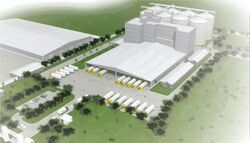Biology:Imota rice mill
The Imota rice mill is an agricultural plant in Ikorodu, a suburb of Lagos, Nigeria. It was built in 2021 and will commence full production in the second quarter of 2022.[1][2]
Capacity
The rice mill has a capacity to produce 2.8 million bags of 50kg bags of rice yearly, while generating 1,500 direct jobs and 254,000 indirect jobs. On completion, in line with the estimated installed infrastructure of the facility, the production capacity of the rice mill in Imota will set it among the largest in the world, and the largest in sub-Saharan Africa.[3]
Economic effect
According to Lagos State gouvernour Sanwo-Olu, full production of the facility will drastically reduce prices of rice and pressure to purchase the commodity.[4] At this moment (early 2022) Nigeria produces husk rice, yet imports hulled/polished rice at a higher price.[5] Processing the national staple food rice in its own country therefore should improve Nigeria's trade balance.
Technical process
In a rice mill, primarily the cereals spelt, barley, oats, millet and rice are hulled, i.e. the husks that are firmly attached to the grain and do not fall off during threshing are removed (dehusking). The husks are indigestible for the human organism and would negatively influence the taste and chewing sensations. Furthermore, in a rice mill, the hulled cereal grains are usually also subsequently rolled (oat flakes), cut (groats) or polished (rice, rolled barley). Other possible processing steps are mostly identical to those in a grain mill.
Surroundings
The State Government is also developing an industrial park adjacent to the mill. Governor Sanwo-Olu said the park would have amenities that would make businesses thrive and bring returns on investment to business owners.
Outlook
In order to facilitate a seamless supply of input for the facility, Lagos will undertake a backward integration strategy in the form of collaboration with other Nigerian states such as Kwara, Sokoto, Benue, Borno and Kebbi to meet the paddy requirement of the mill.[6]
References
- ↑ "Imota rice mill to start production 2022 - Sanwo-Olu" (in en-GB). 2021-12-10. https://www.premiumtimesng.com/news/more-news/500267-imota-rice-mill-to-start-production-2022-sanwo-olu.html.
- ↑ Online, Lagos Post (2022-01-02). "2022 Will Be A Season Of Consolidation, Sanwo-Olu Assures Lagosians | Lagos Post Online" (in en-US). https://www.lagospostng.com/2022-will-be-a-season-of-consolidation-sanwo-olu-assures-lagosians/.
- ↑ "Lagos multi-billion naira 32MT per hour rice mill to be completed by Q1 2021 - Nairametrics" (in en-US). 2020-12-29. https://nairametrics.com/2020/12/29/lagos-multi-billion-naira-32mt-per-hour-rice-mill-to-be-completed-by-q3-2020/.
- ↑ "Imota rice mill to start production 2022 - Sanwo-Olu" (in en-GB). 2021-12-10. https://www.premiumtimesng.com/news/more-news/500267-imota-rice-mill-to-start-production-2022-sanwo-olu.html.
- ↑ Ajala, A. S.; Gana, A. (2015-10-26). "Analysis of Challenges Facing Rice Processing in Nigeria" (in en). Journal of Food Processing 2015: e893673. doi:10.1155/2015/893673. ISSN 2356-7384. https://www.hindawi.com/journals/jfp/2015/893673/.
- ↑ Uzor, Franklin (2021-12-13). "Lagos Governor says 32MT per hour Imota Rice Mill to be Completed by Q1 2022" (in en-US). https://www.nipc.gov.ng/2021/12/13/lagos-governor-says-32mt-per-hour-imota-rice-mill-to-be-completed-by-q1-2022/.


